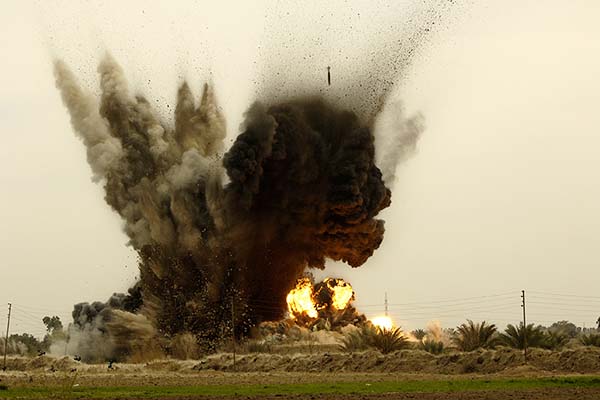
File Photo
American general says militant group retains ability to achieve prominence, but has been hampered by counterterrorism efforts.
The Islamic State’s nascent presence in Afghanistan has dwindled after the U.S. military stepped up strikes on the jihadists, a U.S. general said Thursday, but warned they possess the ability to “catch fire” again.
In the first three months of the year, the U.S. military conducted “just under” 100 counterterrorism strikes in Afghanistan, 70-80 of which targeted the I.S. group, Brigadier General Charles Cleveland said. “The capacity of Daesh, we believe, has been lessened,” the Kabul-based general told reporters. “Their overall footprint in Nangarhar we do believe has been lessened as well,” he said, referring to a province in eastern Afghanistan where I.S. fighters have focused attention on the regional capital Jalalabad.
The U.S. military estimates between 1,000 and 3,000 I.S. fighters are in Afghanistan. Cleveland said the number was likely on the “lower end” of that. They comprise disaffected Pakistani and Afghan Taliban, as well as Uzbek Islamists and locals, Cleveland said.
The Obama administration in January approved new rules loosening when the U.S. military could hit I.S. fighters. Previously, the Pentagon could only do so under limited circumstances, such as for protecting local Afghan troops. Despite recent successes against the I.S. group in Afghanistan Cleveland warned the jihadists could quickly rejuvenate.
“Just based on their past performance they have got the ability to catch fire very quickly. So we do want to continue to have constant pressure on them,” he said in a video call.
Long-established Taliban militants, however, remain a major force and this week announced a Spring offensive. “We’ve seen them begin to reestablish their presence in Helmand [in the south], and we see them on the offense, particularly trying to clear some areas on the eastern part of Helmand,” Cleveland said.
Also present in Afghanistan are 100-300 Al Qaeda fighters, who are rivals of the I.S. group.
Cleveland earlier told AFP the U.S. military is investigating airstrikes it conducted this month in Afghanistan. Kabul said the strikes killed 17 “insurgents” but local officials and witnesses insist they were civilians. On April 6, “U..S forces conducted two counterterrorism strikes in Paktika” province, Cleveland said in a statement. “Currently, there is no evidence of civilian casualties. However, we are conducting a thorough investigation into the strikes,” he added, without saying why they were carried out or the number of victims.
Haji Hussain Khan, a tribal elder from Gomal district, said three drone strikes killed 17 people. District governor Shaista Khan corroborated the account, saying those killed included youths and elders of the Kakarzai tribe returning from a meeting over a land dispute. “The 17 victims were all civilians,” he said.
But an Afghan official, speaking on condition of anonymity, said the dead were “armed insurgents linked to Al Qaeda.”
“All the victims were armed insurgents,” Paktika governor Aminullah Shariq added.
After 15 years of war security in Afghanistan remains fragile. Local troops assumed responsibility for the country’s defenses at the start of 2015, taking over from NATO forces. But the Taliban have hit local troops hard, including in the brief capture of the major city of Kunduz, jolting confidence Afghan government forces can hold their own.
Cleveland said about 5,500 Afghan security forces were killed last year alone. “That’s very difficult for any military to sustain… but the military did not collapse,” he said, adding he was optimistic Afghan forces would fare better in 2016.
